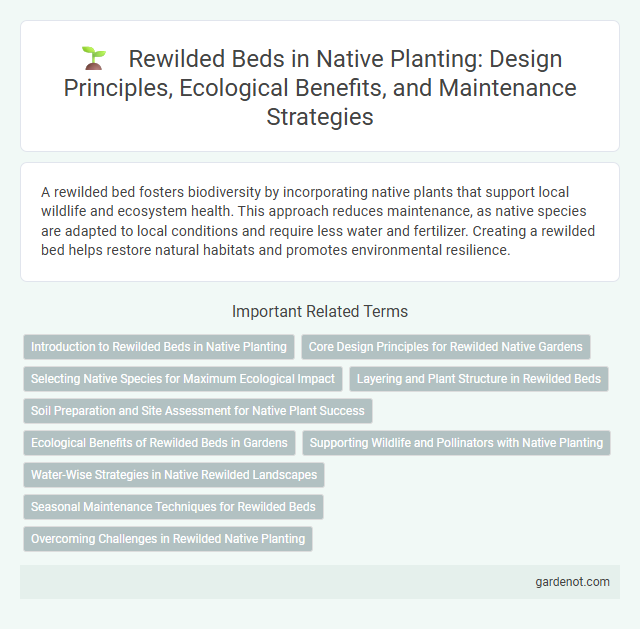A rewilded bed fosters biodiversity by incorporating native plants that support local wildlife and ecosystem health. This approach reduces maintenance, as native species are adapted to local conditions and require less water and fertilizer. Creating a rewilded bed helps restore natural habitats and promotes environmental resilience.
Introduction to Rewilded Beds in Native Planting
Rewilded beds in native planting integrate indigenous flora to restore natural ecosystems and support biodiversity. These beds mimic local habitats, promoting pollinator activity and soil health through diverse plant selection. Emphasizing native species enhances resilience against pests and climate variability, fostering sustainable green spaces.
Core Design Principles for Rewilded Native Gardens
Core design principles for rewilded native gardens emphasize biodiversity by incorporating a diverse mix of indigenous plant species that support local wildlife and ecosystem functions. Soil health and water management are prioritized through the use of native groundcovers and deep-rooted perennials, which enhance nutrient cycling and moisture retention. Such gardens focus on minimal intervention, allowing natural processes like succession and habitat formation to guide plant community development over time.
Selecting Native Species for Maximum Ecological Impact
Choosing native species for a rewilded bed enhances local biodiversity by supporting pollinators, birds, and beneficial insects crucial to the ecosystem. Prioritize region-specific plants that thrive in local soil and climate conditions, ensuring resilience and minimal maintenance. Incorporating diverse native grasses, wildflowers, and shrubs creates layered habitats that maximize ecological functions such as soil stabilization and water retention.
Layering and Plant Structure in Rewilded Beds
Layering in rewilded beds creates diverse plant structures by integrating groundcovers, shrubs, and canopy species to mimic natural ecosystems. This stratification enhances biodiversity, improves soil health, and supports local wildlife by providing varied habitats and food sources. Dense layering also aids in efficient nutrient cycling and moisture retention, promoting resilient and self-sustaining native plant communities.
Soil Preparation and Site Assessment for Native Plant Success
Thorough soil preparation and site assessment are critical for successful native planting in a rewilded bed. Testing soil pH, texture, and nutrient levels ensures compatibility with native species' specific requirements, promoting robust growth and resilience. Identifying existing vegetation, sunlight exposure, and moisture conditions allows for strategic plant selection, enhancing biodiversity and ecological balance.
Ecological Benefits of Rewilded Beds in Gardens
Rewilded beds in gardens significantly enhance biodiversity by creating habitats for native pollinators, birds, and beneficial insects, supporting complex ecological interactions. These beds improve soil health through natural nutrient cycling and reduced erosion, promoting robust plant growth without chemical inputs. By mimicking natural ecosystems, rewilded beds contribute to climate resilience, water retention, and the overall sustainability of urban landscapes.
Supporting Wildlife and Pollinators with Native Planting
Rewilded beds rich in native plant species provide essential habitats, shelter, and food sources that support local wildlife and pollinators such as bees, butterflies, and birds. These native plants enhance biodiversity by promoting natural ecosystems and improving pollination efficiency, which is crucial for maintaining ecological balance. Incorporating diverse native flora in garden design strengthens resilience against pests and climate fluctuations, fostering a thriving environment for pollinators year-round.
Water-Wise Strategies in Native Rewilded Landscapes
Water-wise strategies in native rewilded landscapes emphasize deep-rooted plants such as purple coneflower (Echinacea purpurea) and little bluestem (Schizachyrium scoparium) that enhance soil moisture retention and reduce irrigation needs. Incorporating rain gardens and swales directs runoff to plant roots, promoting natural groundwater recharge while preventing erosion. Mulching with native leaf litter further conserves soil moisture and supports beneficial microbial activity, creating a resilient rewilded bed adapted to fluctuating water availability.
Seasonal Maintenance Techniques for Rewilded Beds
Seasonal maintenance techniques for rewilded beds include targeted pruning, selective weeding, and mulching to promote native plant growth while suppressing invasive species. Regular monitoring during spring and fall helps identify and remove unwanted plants early, preserving biodiversity and soil health. Applying organic mulch in autumn enhances moisture retention and nutrient cycling, supporting robust native ecosystems year-round.
Overcoming Challenges in Rewilded Native Planting
Rewilded beds require careful selection of native plant species that are resilient to local soil and climate conditions, ensuring sustainable growth without excessive maintenance. Managing invasive species is critical to preserve biodiversity and prevent non-native plants from dominating the rewilded area. Implementing adaptive strategies such as seasonal monitoring and soil health improvement enhances the success of native plant establishment in rewilded beds.
Rewilded bed Infographic

 gardenot.com
gardenot.com